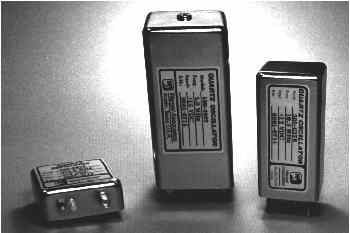High performance crystal oscillators employ temperature control circuitry to hold the crystal and critical circuitry at a precise, constant temperature. The best controllers are proportional, providing a steady heating current which changes with the ambient temperature to hold the oven at a precise set-point, usually about 10 degrees above the highest expected ambient temperature. Temperature induced frequency variations can be greatly reduced by an amount approaching the thermal gain of the oven. The crystal for the oven is selected to have a “turning-point” at or near the oven temperature further reducing the sensitivity to temperature. The combination of the high oven gain with operation near turning point yields temperature stabilities as good as 0.0001 PPM over a temperature range that would cause the crystal to change by 10 PPM.
Highly polished, high-Q crystals which often have significant activity dips may be designed with no activity dips near the operating temperature providing better stability and phase noise than crystals designed for wide temperature ranges. Ovens also allow the use of SC-cut crystals which offer superior characteristics but which are impractical for ordinary TCXOs because of their steep frequency drop at cooler temperatures.
Oven oscillators come in all levels of performance and complexity. Low cost oven oscillators provide better temperature stability than more expensive TCXOs but the power consumption is much higher. At the other end of the spectrum are high-performance oven oscillators exhibiting superb short-term stability, very low aging rates and high immunity to temperature and other enviornmental effects. Oven oscillators insulated with Dewar flasks instead of foam are available for superior temperature performance and lower power consumption.
Oven oscillators require a few minutes to warm and the power consumption is typically one or two watts at room temperature. SC-cut crystals stabilize as soon as they reach the operating temperature but AT-cut crystals exhibit a significant thermal transient effect which can take many minutes to settle. A typical AT-cut crystal will drop in frequency well below any point on the static crystal curve due to the sudden application of oven heat. The frequency will exponentially drift back up to the nominal frequency in most oscillators. In some designs the oven controller overshoots significantly during initial warm-up and then cools back down to the final oven temperature. This cooling transient can kick the AT-cut in the other direction and may actually result in a shorter warm-up time even though the controller takes longer to settle. Hand tweaked designs can achieve fairly good warm-up times with carefully selected overshoot but the advent of quick settling SC-cut crystals obsoleted this approach.
